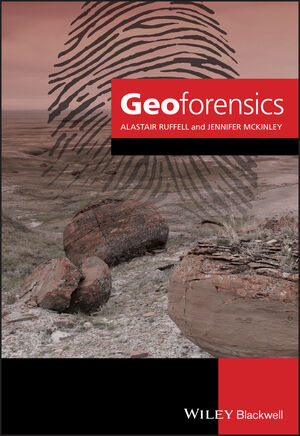GeoforensicsISBN: 978-0-470-05735-3
Paperback
344 pages
October 2008
 Other Available Formats: Hardcover
|
||||||
Acknowledgements ix
Preamble xi
1 Background to the work, organization of the text and history of research 1
1.1 The scene 4
1.2 The victim and materials 5
1.3 The suspect 6
1.4 The scope of geoforensics 8
2 Physical geography, geomorphology, landform interpretation, archaeology, stratigraphy and hydrodynamics 13
2.1 Physical geography 13
2.2 Atmosphere 16
2.3 Types of landscapes, landscape change and human influences on the landscape (short and long term) 18
2.4 Soils 33
2.5 Hydrodynamics of rivers, lakes, estuaries, seas and oceans 47
2.6 Geography, geomorphology, geological and soil maps, and other resources 50
2.7 Groundwater 53
3 Geophysics 55
3.1 Seismic methods: macro to micro 57
3.2 Gravity/gravimetrics 64
3.3 Electrical 66
3.4 Magnetic and electromagnetic 70
3.5 Ground-penetrating radar (GPR) 77
3.6 Radiometrics 85
3.7 Review of why some methods are favoured and others not 88
4 Remote sensing 91
4.1 Definitions 91
4.2 Conventional aerial photography: rural and urban examples 92
4.3 Geoscience use of light photography 93
4.4 Infrared photography 102
4.5 Elevation modelling 104
4.6 Photogrammetry 105
4.7 Synthetic Aperture Radar (SAR) and interferometry 105
4.8 Multispectral and thermal imaging 106
4.9 Hyperspectral imaging 109
4.10 Satellite mapping 109
4.11 Long-distance LiDAR (satellite, aerial) 114
4.12 Laser scanning of scenes and objects 117
4.13 X-ray imagery, X-ray tomography and neutron activation 117
4.14 Field Portable X-ray Fluorescence (FPXRF) spectrometry 122
4.15 Some conjecture on the future of remote sensing applications 124
5 Spatial location and geographic information science 125
5.1 Geographic location and crime 125
5.2 Spatial data and GIS 137
5.3 Spatial analysis within GIS 140
5.4 Use of Google Earth in criminal investigations 152
6 Scale, sampling and geostatistics 155
6.1 Scale and spatial resolution 155
6.2 Sampling for geological materials at urban and non-urban crime scenes 157
6.3 Timing of the crime 157
6.4 Sample size 157
6.5 Lateral variation 159
6.6 Use and misuse of statistics in forensic studies 160
6.7 Statistical sampling 161
6.8 Number of samples required for robust statistical analysis 164
6.9 Comparing ‘like with like’ 165
6.10 Addressing the issue of comparing related material 165
6.11 Spatial and temporal variability in nature 166
6.12 Spatial awareness and use of spatial statistics: application of geostatistics 168
6.13 Geostatistical techniques 172
6.14 GIS and geostatistics 179
7 Conventional geological analysis 183
7.1 Elementary analysis of rocks 185
7.2 Hand-specimen analysis – case studies from Murray and Tedrow (1991) 187
7.3 Sediment analysis 190
7.4 Fossils and microfossils 220
7.5 A paradigm shift in geoforensics? 237
8 Trace evidence 241
8.1 What is geological trace evidence? 241
8.2 Scanning Electron Microscope (SEM) 249
8.3 Laser Raman spectroscopy 253
8.4 Inductively-coupled plasma spectroscopy 253
8.5 Isotope analysis 254
8.6 X-ray diffraction and trace evidence 254
8.7 Manufactured or processed materials that geoscience techniques can analyse 259
8.8 Some conjecture on the future of trace evidence 266
9 The search for buried materials 269
9.1 Introduction 269
9.2 Possible methodologies for non-urban underground searches 274
9.3 Underwater searches and scene mapping (remote sensing, geophysics) 276
9.4 Gas monitoring, organic remains and the decomposition of bodies 288
9.5 Weird and wonderful burial locations 290
10 Circuit complete 293
Appendix 1. Search methods 301
Appendix 2. Soil sampling 305
A.1 Sampling protocol suggestions 305
Glossary 313
References 317
Index 330



